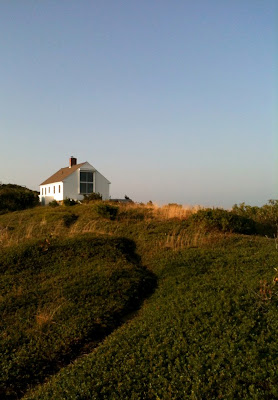Koch Invited for a 16th Residency at Edward Hopper's Former Studio
Photo taken by Philip Koch of Edward Hopper's
S. Truro, MA studioi n the early morning sun.
I'm a fortunate artist.
Over the past year I have been the Artist In Residence at the Burchfield Penney Art Center in Buffalo, NY. On repeated visits there I've studied Charles Burchfield's painting and preparatory drawings at close hand as well as painted out in the landscape locations where he chose to paint. I've gained a far deeper understanding of Burchfield's methods and how his approach to the landscape changed over differnent stages of his career. Particularly valuable was a side trip I made to visit Burchfield's Salem, OH boyhood home.
Yesterday I received the invitation to have a 16th residency in the former studio of Burchfield's friend and fellow painter Edward Hopper in S. Truro, MA on Cape Cod. As an artist myself who originally was inspired by Hopper's work to turn from painting abstractly to working as a realist, the chance to work in the space where Hopper made so many of his world famous paintings has been remarkable.
These two painters Burchfield and Hopper came to know each other because they showed in the Rehn Gallery in New York. Despite the marked differneces in the styles of their realism, they deeply respected each other's work.
Coupled with my experiences on the Burchfield Residency it's also led to some real discoveries about what each artist needed to best stimulate their very individual kind of creativity.
One is how differently these two realist painters approached their subjects. Both were deeply invested in direclty experiencing the landscape, often going for long walks or drives in search of material. Burchfield so often would find his material close at hand. He literally painted his backyard dozens of times in both Ohio and later in the Gardenville suburb where he lived the second half of his life. Often he would paint the interior of his home or studio, so window sills, closet doors and stairways became his major actors.
Hopper on the other hand seemed to relish finding subjects at a distance from where he ate his breakfast. With a few notable exceptions, almost all his work on Cape Cod was painted from locations at least a half mile or more away from his studio building.
Somehow his painter's imagination got fired up better when he had more of a feeling of freshly discovering a new road or house he'd never seen before. Rarely would he paint the same place more than once, preferring to head out in his Buick to find something new to excite his eye.
Burchfield rather preferred the close at hand. Subjects often excited him more if they were familiar. Often he would paint the same building or yard over and over again, always varying his interpretation.
These two artists were blessed with abundant talents. For each of them one of those talents was the ability to recognize what way of working suited them best. They embraced it and the rest is history.
Yesterday I received the invitation to have a 16th residency in the former studio of Burchfield's friend and fellow painter Edward Hopper in S. Truro, MA on Cape Cod. As an artist myself who originally was inspired by Hopper's work to turn from painting abstractly to working as a realist, the chance to work in the space where Hopper made so many of his world famous paintings has been remarkable.
These two painters Burchfield and Hopper came to know each other because they showed in the Rehn Gallery in New York. Despite the marked differneces in the styles of their realism, they deeply respected each other's work.
Coupled with my experiences on the Burchfield Residency it's also led to some real discoveries about what each artist needed to best stimulate their very individual kind of creativity.
One is how differently these two realist painters approached their subjects. Both were deeply invested in direclty experiencing the landscape, often going for long walks or drives in search of material. Burchfield so often would find his material close at hand. He literally painted his backyard dozens of times in both Ohio and later in the Gardenville suburb where he lived the second half of his life. Often he would paint the interior of his home or studio, so window sills, closet doors and stairways became his major actors.
Charles Burchfield's painting of his Gardenville, NY studio,
The Studio, watercolor, 1942. Collection
of the Burchfield Penney Art Center, Buffalo, NY
Somehow his painter's imagination got fired up better when he had more of a feeling of freshly discovering a new road or house he'd never seen before. Rarely would he paint the same place more than once, preferring to head out in his Buick to find something new to excite his eye.
Edward Hopper painted this subject a couple miles north of
his S.Truro studio. Corn Hill, oil on canvas, 1930, McNay
Art Museum, San Antonio, TX
Burchfield rather preferred the close at hand. Subjects often excited him more if they were familiar. Often he would paint the same building or yard over and over again, always varying his interpretation.
These two artists were blessed with abundant talents. For each of them one of those talents was the ability to recognize what way of working suited them best. They embraced it and the rest is history.





